 |
Woodrow
Wilson Bridge, view from north of the bridge, from the Old Town Alexandria
shoreline, looking south toward the bascule span of the bridge.
The next 3 photos are from the same vantage point, with the camera lens
increasing successively to wider angles.
|
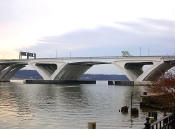 |
Woodrow
Wilson Bridge, view from north of the bridge, from the Old Town Alexandria
shoreline, looking south toward the bascule span of the bridge.
A white surfacing has been applied on the concrete surface of the bridge
piers and on the surface of the steel girders, and this surfacing is polymer-based
with a mixture of fine aggregate, designed to be very durable and to last
for many years, and designed to make the bridge glow at day and at night.
The underside of the bridge also has lighting to illuminate it at night.
|
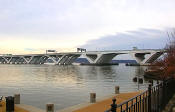 |
Woodrow
Wilson Bridge, view from north of the bridge, from the Old Town Alexandria
shoreline, looking south toward the bascule span and Maryland approach of
the bridge.
The Potomac River has a naturally deep channel in this area, and it is
about 500 feet from the Virginia shoreline at this point, and it is about
22 feet deep, and that is the shipping channel, and that is the location of
the bascule span. The Potomac River in this area ranges from 3/4 to 1 mile
wide.
|
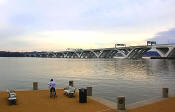 |
Woodrow
Wilson Bridge, view from north of the bridge, from the Old Town Alexandria
shoreline, looking south toward the Maryland approach of the bridge.
The new bascule span has 70 feet of vertical navigational clearance when
the drawspan is closed, 20 feet higher than the original bridge's bascule
span which had 50 feet of vertical navigational clearance when its drawspan
was closed. The original drawspan opened approximately 260 times per year
to allow for the passage of marine traffic with greater than 50 foot height
above water. Because the new drawbridges are 20 feet higher than the pre-existing
bridge, the number of openings will be reduced to about 65 per year (or about
one per week), about a 75 percent reduction.
|
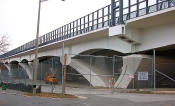 |
Woodrow Wilson Bridge, Virginia approach, near Royal Street in Alexandria.
Notice the sound barrier along the side of the bridge, to reduce the noise
impacts to Old Town Alexandria. A 1,550-foot transparent wall on the new Wilson
Bridge provides soundproofing for Old Town Alexandria residents while preserving
the view from the bridge; and the wall, made of acrylic panels called Paraglas,
is 17 feet tall.
The next 2 photos are from the same vantage point.
|
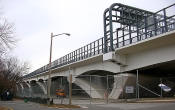 |
Woodrow Wilson Bridge, Virginia approach, near Royal Street in Alexandria.
On the nearside of the sound barrier there is a path, that is part of the
pedestrian/bicycle path that will connect the two states via a separated path
along the north edge of the Inner Loop WWB, and the trail will carry pedestrian/bicycle
traffic between US-1 south of Alexandria and pedestrian/bicycle trails in
Maryland. The pedestrian/bicycle path will open to traffic in early 2009 when
connecting facilities are completed.
|
 |
Woodrow Wilson Bridge, Virginia approach, near Royal Street in Alexandria.
The bridge's Virginia abutment (bridge terminal structure) is in the center
of the photo, and is the point where the Virginia end of the WWB meets the
land Beltway approach. The end of the bridge is also where the transparent
sound barrier changes to a conventional reinforced concrete sound barrier.
The low parapet (bridge railing) is alongside the pedestrian/bicycle path.
|
Copyright © 2009 by Scott Kozel. All rights reserved. Reproduction, reuse,
or distribution without permission is prohibited.







